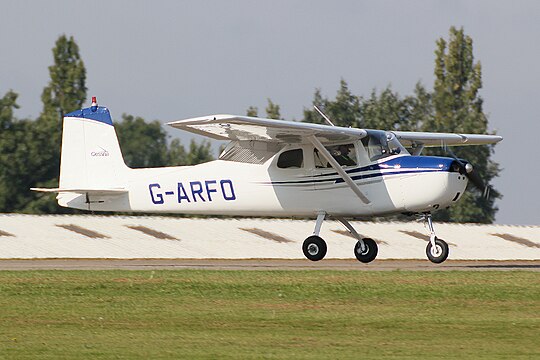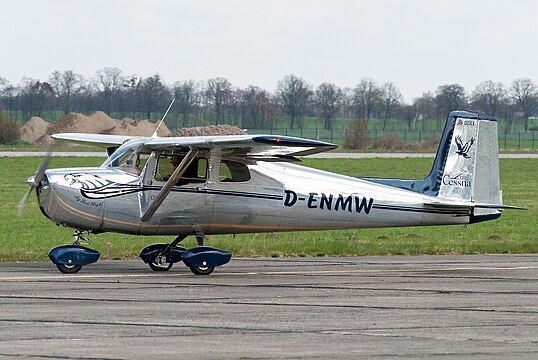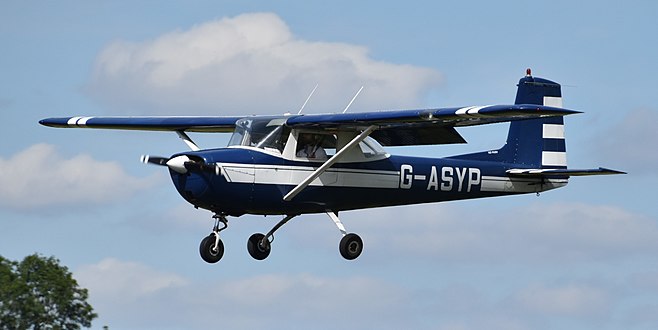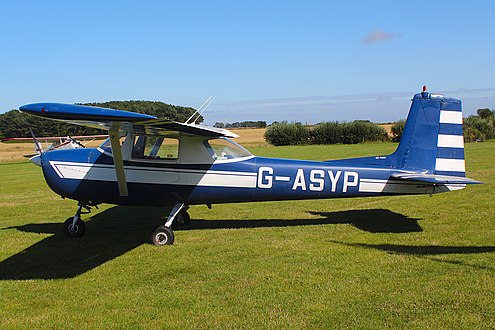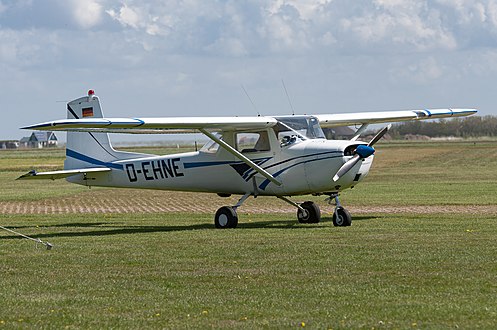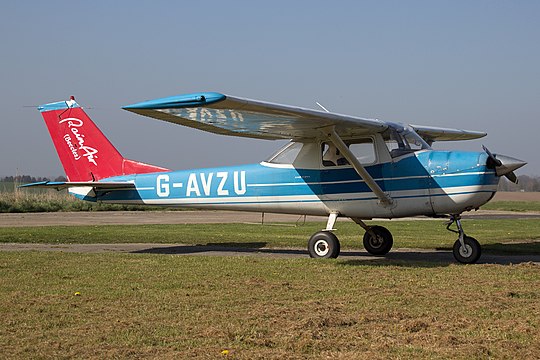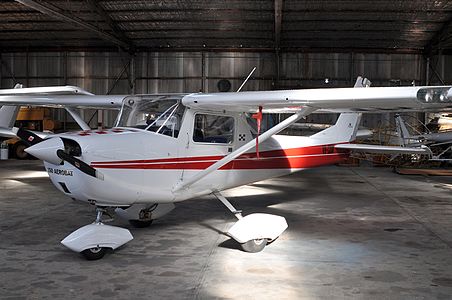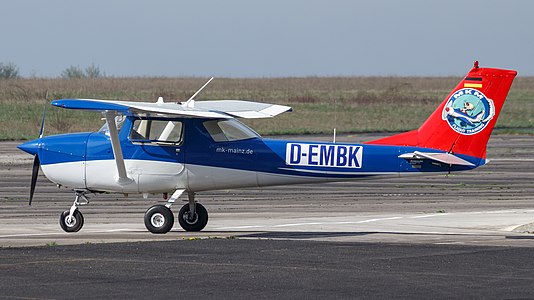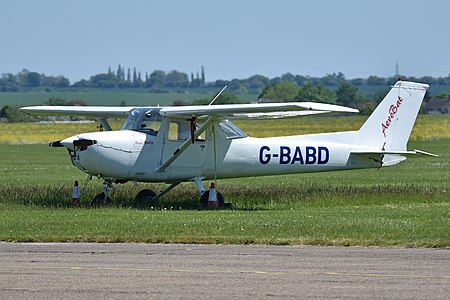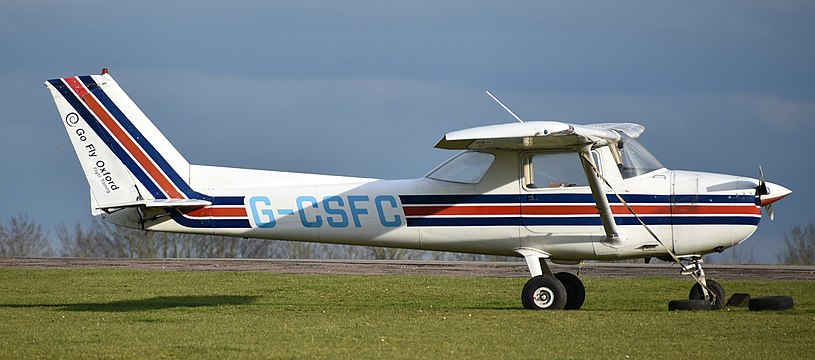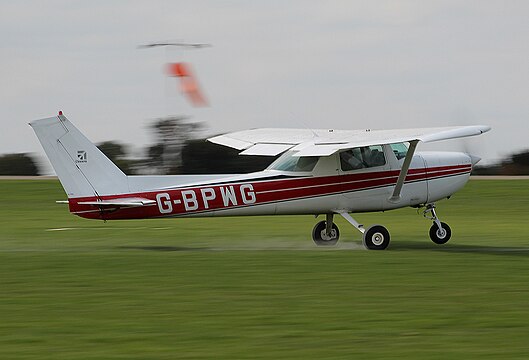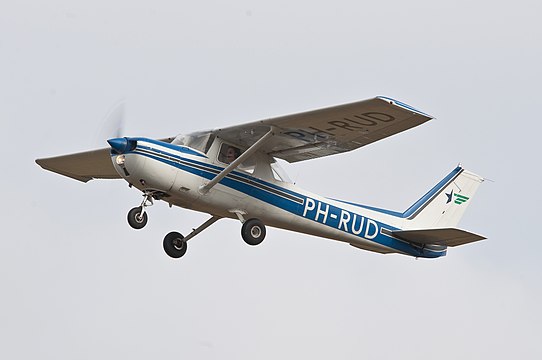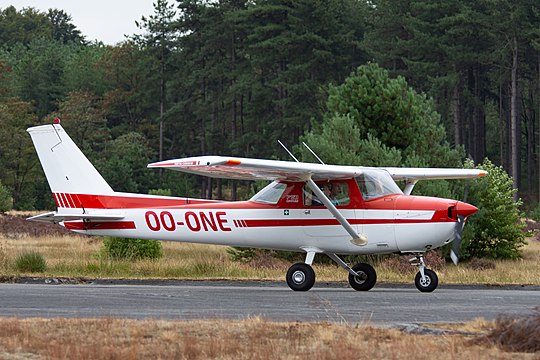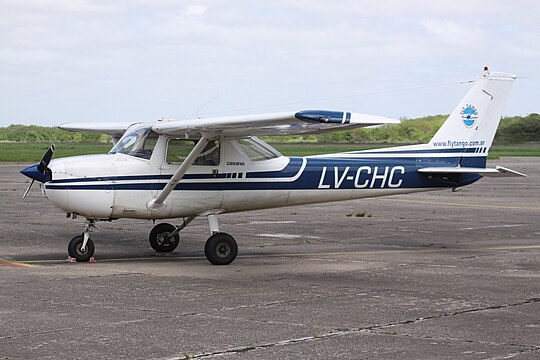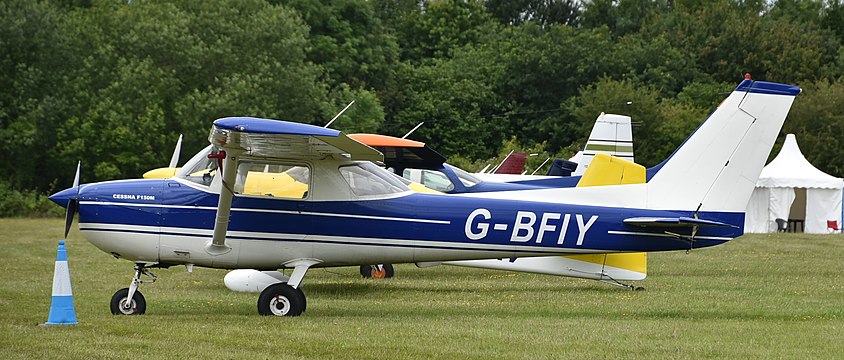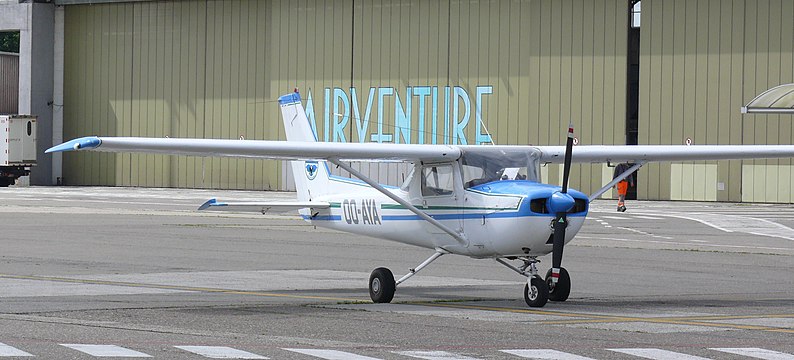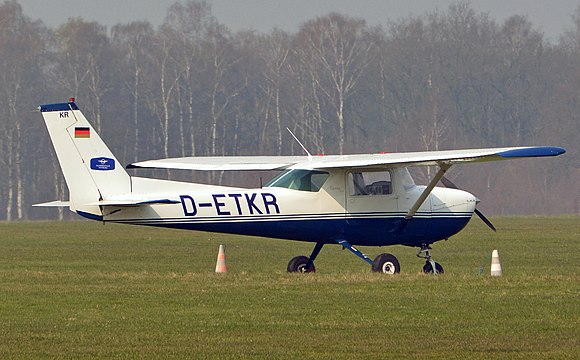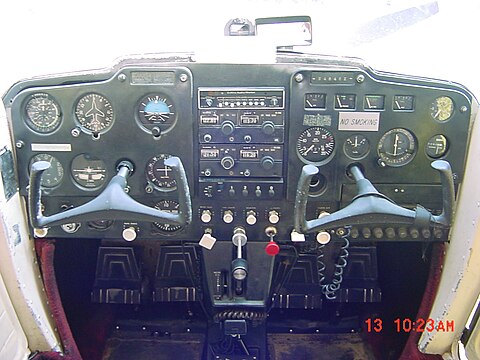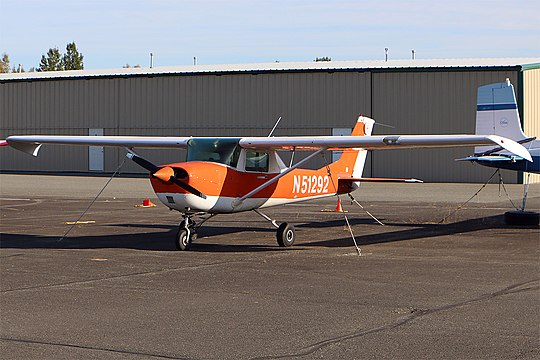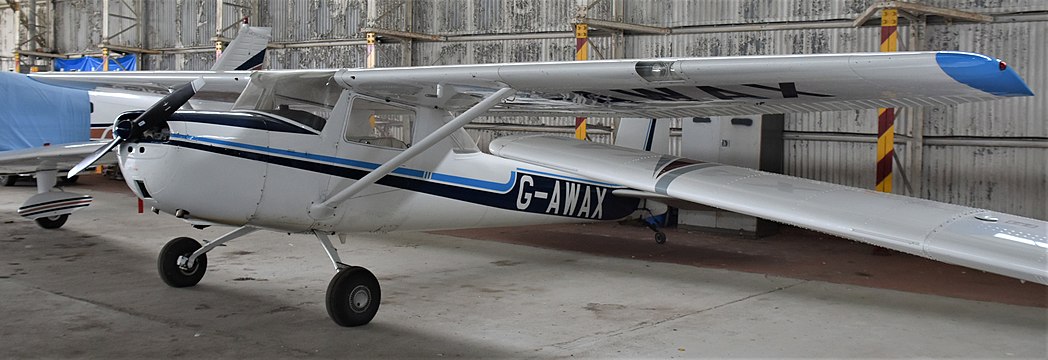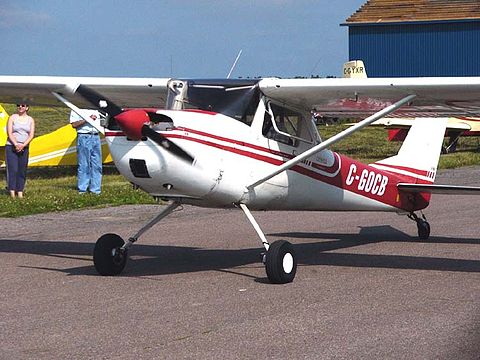Cessna 150
The Cessna 150 is a single-engined light aircraft with a high-mounted wing, nosewheel landing gear, and two seats placed side by side, made by Cessna from 1958 through 1977. It is commonly used for flight training. With a total of 23,839 aircraft built of all models, it is the fifth most-produced aircraft ever and the most-produced two-seat civil aircraft.
Original Cessna 150 (no suffix, 1958–1960)[edit]
The original Cessna 150, introduced in 1958 and produced through 1960, had no suffix. It was very similar in most respects to the versions which immediately followed, the 150A, 150B, and 150C, but can be distinguished by its rear side windows, which are smaller and roughly triangular, tapering toward the back.
-
LN-FAF in the Norwegian Aviation Museum
-
G-ARAU in 1969
-
C-FXGR
Cessna 150A, 150B, and 150C (1961—1963)[edit]
The Cessna 150A, 150B, and 150C, of 1961, 1962, and 1963 respectively, all look nearly identical and very much like the original 150, differing from it only in having larger, nearly rectangular rear side windows.
-
G-ARFO, a 150A (more photos)
-
N1280Y, a 150B (more photos)
-
G-ARFO
-
D-ENMW, a 150C; the speed fairings are in a 150A/150B style (more photos)
-
G-ARFO with flaps fully down
-
C-GARF, a 150B
-
C-FIII, a 150B with special "Patroller" doors having an extra window in the lower half
-
C-FKHV, a 150C
-
N7276X, a 150B
-
G-ARFO
-
VH-ACO, a 150B
-
G-ARFI, a 150A
Cessna 150D and 150E (1964—1965)[edit]
The Cessna 150D and 150E of 1964 and 1965, respectively, show the first major change in the 150's look. Earlier 150s have a "fastback"-style aerodynamic fairing behind the passenger cabin, along with the two rear side windows previously mentioned. Starting with the 150D, the fairing and rear windows were eliminated, replaced by a single wraparound rear window which Cessna called "Omni-Vision". This greatly improved all-around visibility and light, though it reduced speed and aerodynamic efficiency, and the change persisted through the rest of the 150 line. The 150E looks the same as the 150D.
-
G-ATEF, a 150E (more photos)
-
G-ATEF
-
G-ASYP, a 150E (more photos)
-
G-ATEF
-
G-ASYP
-
G-ATEF
-
N4337U, a 150D
-
G-ATEF
-
G-ASYP
-
D-EHNE, a 150D
-
G-ATEF
-
LN-BGR, a 150D
-
VH-DMJ, a 150E (more photos)
-
C-FSGO, a 150E
-
VH-DMJ
Cessna 150F, 150G, 150H, and 150J, and Reims F150F, F150G, F150H, and F150J (1966–1969)[edit]
With the Cessna 150F of 1966, the 150 acquired basically its final, modern look, maintained with relatively minor changes in all subsequent 150s and their 152 successors. The straight vertical fin and rudder of the older 150s was replaced with a strongly swept fin and rudder like that already adopted in larger Cessnas. (This fin certainly makes the newer 150s look faster, but this is strictly a visual illusion—it actually does nothing for speed.) The cabin doors were also widened and no longer taper toward the bottom.
Changes in the following models, the 150G, 150H, and 150J of 1967, 1968, and 1969, respectively, were mostly internal. Externally they look nearly identical to the 150F. The doors in the 150G were bowed outward slightly to increase shoulder and hip room, but this is very hard to see in a photo. A more obvious visual difference between the 150F and the 150G is the style of the door hinges. Another is the optional beacon at the top of the tail fin, if equipped; the 150F's revolving beacon has a broader mounting than the flashing beacon introduced with the 150G, and usually the 150F's beacon is also taller. In the 150H and 150J, the wing struts have curved fairings added to where they meet the wing and fuselage. There is no visible exterior difference between 150H and 150J models.
Also starting with the 150F, the 150 was built in France by Reims Aviation under license as the Reims F150, with specific models F150F, F150G, etc. These are identical to their Cessna-made counterparts. Reims F150s are more common in Europe.
The following photos are of 150F through 150J models. All of the aircraft in these photos have the original conical propeller spinner and the original uncambered wingtips. Many 150 owners have replaced the wingtips with cambered ones like those on the 150K and later models; some have installed far more strongly curved wingtips designed for STOL operation. Since the wingtips are the key visual difference between the 150F-150J models and the following 150K model, only original wingtips are shown here.
-
G-ATMC, an F150F (more photos)
-
N6966F, a 150F
-
G-AVER, an F150G (more photos)
-
SP-MAH, a 150J (more photos)
-
ES-ECB, an F150J
-
G-BOTP, a 150J (more photos)
-
RA-67486, a 150F (more photos)
-
G-AWPU, an F150J
-
SP-MAH, a 150J
-
N6297R, a 150F in mock U.S. Air Force garb. (The Air Force actually used the much later 150L and 150M.)
-
G-AVMF, an F150G (more photos)
-
HS-ATD, a 150H
-
G-ATMC, an F150F
-
I-ALPP, an F150J (more photos)
-
G-AVEO, an F150G (more photos)
-
G-AVZU, an F150H
-
OO-JRB, an F150J
-
D-EGDY, an F150G (more photos)
-
G-AWUU, an F150J (more photos)
-
G-ATRM, an F150F
-
D-EGDY, an F150G
-
G-USAA, an F150G (more photos)
-
RA-67486, a 150F
-
C-FAOB, a 150J
-
G-ATKF, a 150F (more photos)
-
G-BPGZ, a 150G
-
VH-KQU, a 150H (more photos)
-
G-ATMM, an F150F
-
PH-BWR, an F150H
-
VH-KQU, a 150H
Cessna 150K and A150K Aerobat and Reims F150K and FA150K Aerobat (1970)[edit]
Cessna introduced the 150K in 1970. This mostly looks similar to the preceding 150F to 150J models, but the 150K has redesigned wingtips with a noticeable downward curve, or "camber". These wingtips were claimed to slightly improve the 150K's performance. (Many owners of 150F through 150J models have installed similar wingtips, though these are not shown in the preceding gallery.) The 150K also has a ground-adjustable rudder tab which can be seen as a vertical "kink" at the rudder's bottom edge. (Again, a similar tab has sometimes been added to older models.)
With the 150K, Cessna also offered a special aerobatic version, called the A150K Aerobat, with structural reinforcements to withstand intense maneuvering. The A150K Aerobat looks identical to the 150K, except that it has standard skylights in its cabin roof, which are optional on the ordinary 150K. On the other hand, the 150K's cambered wingtips are likewise optional on the A150K Aerobat, so some A150Ks may have the older wingtip style (G-LALA is an example of this in the photos below). Aerobats often have checkered areas in their paint schemes, inspired by Cessna's original paint style for them.
As before, Reims made French-built versions of these models as the F150K and FA150K Aerobat which are identical to their Cessna-built counterparts.
-
D-ECEW, an F150K
-
G-AYCF, an FA150K Aerobat (more photos)
-
D-ECHB, an F150K
-
PH-VRW, an FA150K Aerobat (more photos)
-
G-AYCF, an FA150K Aerobat
-
PH-VRW, an FA150K Aerobat
-
PH-VRW, an FA150K Aerobat
-
G-AYCF, an FA150K Aerobat
-
G-AYGC, an F150K (more photos)
-
G-KOVU, an FA150K Aerobat
-
VH-CDW, an A150K Aerobat (more photos)
-
VH-CDW, an A150K Aerobat
-
G-BJOV, an F150K (more photos)
-
G-LALA, an FA150K Aerobat (more photos)
-
N600SU, a 150K
-
D-EMBK, an F150K
-
G-BHRH, an FA150K Aerobat (more photos)
Cessna 150L and A150L Aerobat and Reims F150L, FA150L Aerobat, and FRA150L Aerobat (1971–1974)[edit]
In 1971, Cessna introduced the 150L, which further changed the 150's appearance. The dorsal strake in front of the vertical fin was made much longer, extending nearly to the rear window. The main landing gear was widened, with tubular legs instead of the former legs made of flat spring steel. Finally, the landing light was moved from the leading edge of the left wing to the nose, just below the propeller spinner. (Some aircraft have optional twin nose lights, one for landing and one for taxiing.) As with the 150K, Cessna also made an aerobatic version, the A150L Aerobat, with the same structural reinforcements and roof skylights as in the preceding Aerobat; the A150L looks almost identical to a standard 150L, except perhaps for the roof skylights and sometimes the paint scheme.
Reims also made a French-built version of the 150L, the F150L, as well as two different French-built versions of the A150L Aerobat. The first of these, the FA150L Aerobat, was identical to the Cessna version; this was only produced for 1971. The second version, the FRA150L Aerobat, produced for 1972 through 1974, changed the engine, replacing the 150's standard Continental O-200 with a larger, more powerful Continental O-240 built under license by Rolls-Royce, as indicated by the added "R" in the designation. (Other Reims F150s also had Rolls-Royce-built engines, but they were O-200s.) There are no visible differences between the Cessna-built and Reims-built 150Ls, not even the FRA150L, whose larger engine still fits in the usual 150L cowl.
Cessna and Reims produced the 150L models for four years, 1971 through 1974. Modest changes were made each year, but most of these are not externally visible.
-
RA-67716, a 150L (more photos)
-
An unidentified 150L
-
G-BAXU, an F150L (more photos)
-
G-JHAC, an FRA150L Aerobat (more photos)
-
G-BIFY, an F150L (more photos)
-
D-ECPP, an FA150L Aerobat (more photos)
-
G-JAGS, an FRA150L Aerobat (more photos)
-
G-BCKV, an FRA150L Aerobat (more photos)
-
G-BCVG, an FRA150L Aerobat (more photos)
-
N11435, a 150L (more photos)
-
N6053J, an A150L Aerobat (more photos)
-
G-AZZR, an F150L (more photos)
-
G-BTHE, a 150L (more photos)
-
ZS-ILG, an A150L Aerobat (more photos)
-
N3279G, an F150L in mock U.S. military garb (more photos)
-
G-BABD, an FRA150L Aerobat (more photos)
-
G-BAEP, an FRA150L Aerobat (more photos)
-
D-EGCJ, an F150L (more photos)
-
G-KWET, a 150L
-
PH-LMJ, an FA150L Aerobat
-
HA-JDH, an F150L (more photos)
-
D-ECPP, an FA150L Aerobat
-
OO-HBI, an F150L
-
G-BUCT, a 150L (more photos)
-
G-BEOY, an FRA150L Aerobat (more photos)
-
G-BAYP, a 150L (more photos)
-
D-ECUJ, an FRA150L Aerobat (more photos)
-
G-AYRO, an FA150L Aerobat (more photos)
-
G-CSFC, a 150L (more photos)
-
D-ECUJ, an FRA150L Aerobat
-
G-BCDY, an FRA150L Aerobat (more photos)
-
G-BAYP, a 150L
Cessna 150M and A150M Aerobat and Reims F150M and FRA150M Aerobat (1975–1977)[edit]
Cessna introduced the final 150 version, the 150M, in 1975. This version made one last change to the 150's appearance, extending the tail fin and rudder upward by about six inches so that the vertical tail is visibly taller, with a narrower tip and a larger balance horn on the rudder. The aerobatic version was now the A150M Aerobat. Reims also continued to make license-built versions as the F150M and FRA150M Aerobat, the latter with the same larger O-240 engine as the preceding FRA150L Aerobat. The 150M stayed in production for three years; again, there were minor changes for each model year that are not externally visible. Production finally ended in 1977 to make way for the 150's replacement, the Cessna 152. The 150M actually looks nearly identical to the 152, to the point that they can be hard to tell apart.
-
D-EGLP, a FRA150M Aerobat (more photos)
-
G-BPWG, a 150M (more photos)
-
G-CLHN, an F150M (more photos)
-
PH-RUD, an F150M
-
PH-HVP, an F150M
-
PH-CAN, a 150M (more photos)
-
G-GLED, a 150M (more photos)
-
N150ER, a 150M (more photos)
-
G-BPWG, a 150M
-
OO-ONE, an F150M
-
F-BXQN, an F150M (more photos)
-
G-CSBM, an F150M (more photos)
-
G-GLED, a 150M
-
OE-ASK, a 150M (more photos)
-
F-BXQO, an F150M
-
LV-CHC, a 150M
-
G-CSBM, an F150M
-
PH-CAN, a 150M
-
G-BFIY, an F150M (more photos)
-
G-HIVE, an F150M (more photos)
-
PH-TGA, an F150M
-
G-OMAS, an A150M Aerobat (more photos)
-
OO-AYA, an F150M (more photos)
-
F-OJAE, a 150M (more photos)
-
G-BFOG, a 150M
-
OO-PRH, an F150M
-
G-BDTX, an F150M
-
D-EDIC, an F150M (more photos)
-
RA-1654G, an A150M Aerobat (more photos)
-
G-BDOD, an F150M (more photos)
-
D-ETKR, a 150M (more photos)
-
G-BFGG, an FRA150M Aerobat (more photos)
-
D-EDIC, an F150M
Cessna 150 floatplanes[edit]
Some Cessna 150s have been equipped as floatplanes, though these are relatively rare.
-
C-FEEK, a 150F floatplane
-
N8687J, a 150G floatplane with aftermarket "droop" wingtips (see the section below on modified wingtips)
Cessna 150 cockpits[edit]
Many of the changes in successive Cessna 150 models were in the cabin interior and in the cockpit panel's controls and instruments. Several Cessna 150 cockpits are shown below.
-
Cockpit of N4846X, a 150G
-
Cockpit of SP-KNC, a 150L
-
Cockpit of G-AZJY, an FRA150L Aerobat
-
Cockpit of C-GNXD, a 150L (brightened from the original photo)
-
Cockpit of C-GEYW, a 150M (brightened from the original photo)
-
Cockpit of F-OJAE, a 150M
Cessna 150 modified wingtips[edit]
On all Cessna 150 models before the 150K, the original wingtips were ordinary streamlined fairings with no downward curve. Beginning with the 150K, the wingtips were changed to a "conically cambered" form that curved downward at the tip, with the curvature increasing toward the tip's trailing edge. This was claimed to make the wing slightly more efficient, improving performance and economy, and many owners of earlier 150 models have installed similar aftermarket wingtips on their aircraft. Some 150s, modified for STOL (short-takeoff-and-landing) operation, have much more extreme downward-curving "droop" wingtips which make the ailerons more effective at very low speeds.
-
The standard pre-150K wingtip seen on G-BPGZ, a 150G
-
This F150G, G-AVIT, has 150K-style wingtips installed (more photos)
-
N51292, a 150J, has "droop" wingtips
Cessna 150 taildragger conversions[edit]
Although the Cessna 150 has always been a tricycle-gear aircraft, over the years some have been converted to "taildraggers" with tailwheel landing gear.
-
PR-GBM, a 1959-model 150
-
N7177X, a 150A
-
G-AWAX, a 150D (more photos)
-
G-ASMW, a 150D
-
VH-PPP, a 150F
-
C-GOCB, a 150F
-
C-GASU, a 150G (more photos)
-
N3345J, a 150G (more photos)
-
G-TXAS, an A150L Aerobat
-
N150GN, a 150M
-
VH-DTW, a 150M
Cessna 150 engine: Continental O-200[edit]
The standard engine of the Cessna 150 is the Continental O-200, an air-cooled horizontally-opposed four-cylinder piston engine of 201 cubic inches (3.29 l) displacement rated for 100 horsepower (75 kW). The exception is the Reims-built FRA150 Aerobat, which has a Rolls-Royce-built version of the larger and more powerful Continental O-240.
The following are three views of a Cessna 150H's O-200-A engine, with the cowling removed.






